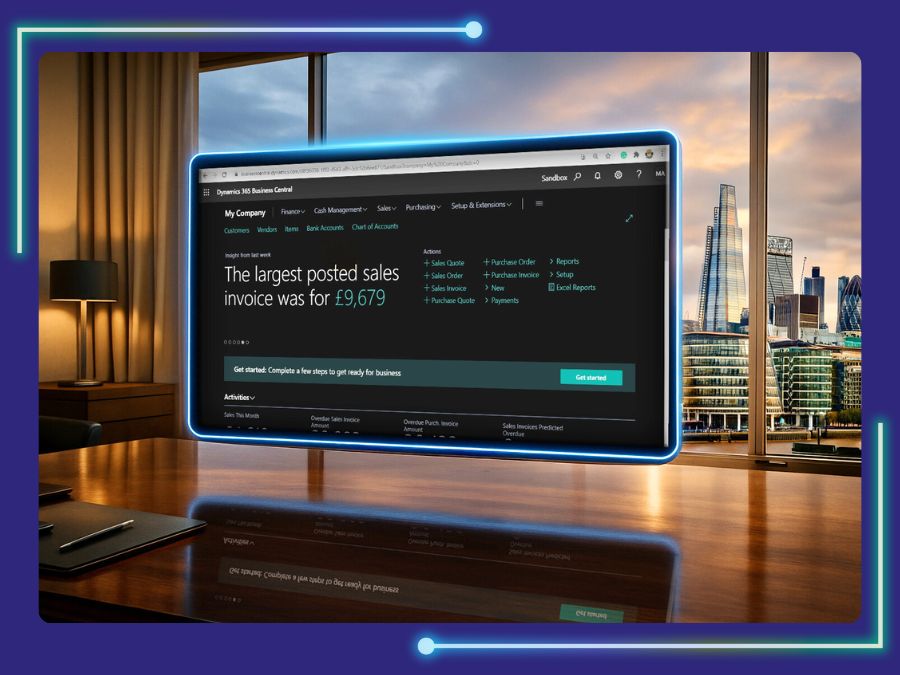Table of Content
Share This Article
- Published: Sep 6, 2025
- Last Updated: Sep 15, 2025
- 🔊 Listen
Quick Reads
- The primary reason UK firms are migrating from Xero to Business Central is to gain advanced financial management, enhanced scalability, and deeper analytics that support business growth.
- The platform offers native integration with the Microsoft ecosystem, including office 365 and Power BI, enabling unified, real-time reporting and automation.
- A successful migration from Xero to Business Central requires a meticulous roadmap that includes assessment, data preparation, migration, testing, and go-live.
- For a seamless transition, engage key stakeholders early, partner with experienced migration experts, and thoroughly outline new workflow.

MS Dynamics, Refined
Automation Aligned With Your Accounting Strategy
For many UK businesses, the move from Xero to Microsoft Dynamics 365 is less about replacing what works and more about preparing for what’s next. Xero offers flexibility for small to mid-sized operations, but larger or fast-scaling firms often need deeper consolidation, advanced reporting, and stronger compliance management.
A well-planned Xero to MS Dynamics migration ensures finance teams can handle complex requirements with confidence while aligning systems more closely to long-term business goals. In this blog, we will take you through the entire migration process to ensure seamless efficiency.
Why Migrate from Xero to Business Central?
Migrating to Business Central means future-proofing your finance function with scalability, advanced financial tools, Microsoft ecosystem integration, extensions, and compliance safeguards. Here’s why it’s important for your business today.
Designed for growth and scalability:
Business Central is built for organisations that are expanding in size and complexity. It can seamlessly manage multi-entity structures, multi-currency transactions, and multi-country operations, features that quickly go beyond the scope of what Xero can handle.
Advanced financial management:
Beyond basic bookkeeping, Business Central delivers richer functionality such as dimensions (for detailed analysis), cost allocations, intercompany postings, and advanced reporting tools. These capabilities provide deeper insights and tighter control over financial performance compared to Xero.
Seamless Microsoft ecosystem integration:
Business Central connects natively with Office 365, Power BI, Power Automate, and Microsoft Teams, which ensures smoother collaboration, real-time reporting, and automated workflows. This eliminates manual processes and integrates finance with day-to-day business operations.
Flexibility through extensions:
With access to a wide range of industry-specific apps and add-ons via Microsoft AppSource, Business Central can be tailored to meet the unique needs of sectors such as retail, professional services, manufacturing, or distribution, offering flexibility far beyond Xero’s limited customization.
Stronger compliance and controls:
As businesses grow, compliance and regulatory needs increase significantly. Business Central provides robust approval workflows, comprehensive audit trails, role-based security, and structured internal controls, making it far more suitable for organisations operating in regulated environments or those requiring rigorous financial governance.

Benefits of Moving to Microsoft Dynamics 365
Moving to Microsoft Dynamics from Xero offers several benefits, such as unified ERP solution, robust reporting & analytics, accounting automation, and multi-level consolidation. It also offers customised solutions, global compliance, audit readiness, and managing high volume data. Here are the benefits explained:
Unified ERP solution
Microsoft Dynamics 365 offers a unified ERP system that integrates finance, supply chain, sales, and customer service into one platform. This consolidation provides UK businesses with improved operational visibility and control, reducing time spent switching between systems.
Robust reporting & analytics
Dynamics 365 delivers powerful reporting and analytics through integrated tools like Power BI. UK organisations gain real-time insights into financial performance, customer behaviour, and operational efficiency. These data-driven insights aid swift, informed decision-making aligned with local market demands and regulatory needs.
Advanced automation
The platform enables extensive automation of routine tasks such as invoicing, data entry, and customer communications. For UK businesses, this reduces human error and operational costs while speeding up processes. Customisable workflows allow adaptation to sector-specific requirements and streamline compliance handling.
Multi-entity consolidation
Dynamics 365 excels at multi-entity consolidation, supporting UK firms managing multiple subsidiaries or branches. It handles different currencies, fiscal calendars, and charts of accounts, producing accurate, consolidated financial reports. This simplifies group accounting and improves corporate oversight.
Customization
Extensive customisation options let UK businesses tailor Dynamics 365 to their processes without unnecessary complexity. From modifying workflows to integrating industry-specific applications, users can shape the system to drive efficiency while maintaining ease of use.
Global compliance
Built with compliance in mind, Dynamics 365 supports UK regulations such as VAT, Making Tax Digital (MTD), and GDPR. Its features ensure accurate tax submissions and data protection, helping organisations meet government requirements seamlessly.
Compliance & Audit Readiness
Dynamics 365 provides built-in audit trails, secure data management, and reporting features that prepare UK businesses for regulatory reviews. Automated logging and control access enhance transparency and simplify audits, reducing the risk of non-compliance penalties.
Volume of Data
Designed to handle growing data volumes, Dynamics 365 can efficiently process large datasets common in UK businesses. Cloud-based storage and computing ensure systems remain responsive, giving users quick access to relevant information without performance loss.
Migration Roadmap of Xero to Business Central
A full migration from Xero to Business Central involves meticulous assessment, data preparation, migration execution, thorough testing, and targeted support, with a clear focus on compliance and local requirements. Below is the detailed roadmap of migrating to Business Central from Xero:
Assessment & Planning:
- The migration journey should start with a detailed review of the existing Xero setup, covering the chart of accounts, tax codes, dimensions, and any custom reports currently in use.
- Once this baseline is established, it becomes easier to define the migration scope by deciding whether to bring in full historical data or limit it to opening balances.
- With that clarity, the next step is to map current business processes against Business Central’s capabilities, which helps highlight both alignments and gaps.
- Together, these activities provide the groundwork for a smooth transition, ensuring there are no surprises later and that attention remains on the most critical areas.
Data Preparation:
- It is essential to clean the source data in Xero, which includes removing inactive accounts and eliminating duplicate customer or vendor records to protect data integrity.
- At the same time, controls should be applied to prevent duplicate account creation within the new system.
- Once the data is refined, posting groups must be assigned to customers, vendors, and items to match the structure in Business Central.
- Critical datasets, such as outstanding AR/AP invoices, bank reconciliations, and fixed asset registers should then be exported.
- Finally, the chart of accounts from Xero needs to be standardised and mapped to Business Central accounts before exporting master data such as customers, vendors, items, and GL balances.
Migration Execution in Business Central:
- With the preparation complete, Business Central’s built‑in migration tools can be used to import master data in a controlled manner.
- At this stage, other critical configurations, such as dimensions, posting groups, series setups, fixed assets, tax codes, and integrations must also be set up for optimal system performance.
- Particular attention should be given to mapping VAT codes and dimensions in accordance with UK tax regulations.
- To safeguard accuracy, control mechanisms such as preparer–checker–approver workflows should be implemented.
- Depending on business needs, selected historical transactions may also be brought into the system.
Testing & Validation:
- Once data is migrated, it is recommended to run parallel accounting cycles in both Xero and Business Central for one or two periods, enabling direct comparison of results.
- During this stage, validating the accuracy of key outputs such as financial reports, VAT returns, and management dashboards is essential to ensure consistency between systems.
- Parallel testing should also extend to confirming that integrations with payroll, banking platforms, and third‑party applications are functioning smoothly.
- The finance team then needs to verify that workflows and reporting templates meet operational requirements.
- Additional checks should review general posting setups, with custom report adjustments made where needed to serve business‑specific requirements.
Go-Live & Support:
- When shifting to production, it is best to choose a cut‑over date at the end of a month or quarter to reduce disruption.
- Just before you go‑live, final balances along with any pending transactions should be migrated to ensure a smooth transition.
- At the same time, comprehensive training should be delivered to the finance and operations teams, so they feel confident using Business Central from day one.
Key Points to Keep in Mind:
- For a successful outcome, it is critical to engage stakeholders early, ensuring expectations and requirements are aligned from the start.
- Equally important is defining the data migration scope early on, balancing the effort and cost of a full history migration versus summarised balances.
- Partnering with experts who have prior experience moving from Xero to Business Central can significantly reduce risks and ease the transition.
- After migration, advanced tools such as Power BI can be used to enhance reporting and analytics.
- Finally, workflows and approval processes should be documented thoroughly to preserve strong internal controls.
Optimise Financial Operations with Business Central Accounting Services
Migrating from Xero to Microsoft Dynamics is an investment in control, compliance, and clarity. When handled with expertise, it not only delivers smoother reporting and stronger integration but also equips your finance team with the agility to respond to new opportunities and challenges.
At Whiz Consulting, our MS Dynamics accounting services team manages the heavy lifting of migration, reducing risks while unlocking the full potential of the platform. We handle everything from cleaning and mapping legacy data to configuring integrations, so your move to Dynamics is both accurate and built for long-term efficiency.
And for businesses aiming to sustain this momentum, our accounting outsourcing services extend the value further, offering cost efficiency, specialised talent, and long-term financial stability.

Get customized plan that supports your growth
Have questions in mind? Find answers here...
Businesses usually migrate when they outgrow Xero’s capabilities especially if they need advanced reporting, multi-entity consolidation, deeper inventory management, or tight integration with Microsoft’s ecosystem such as Office 365, Power BI, and Teams.
The complexity depends on your data size, customisations, and reporting needs. A basic setup can be migrated in weeks, but multi-currency, multi-entity, and compliance-heavy businesses may require phased migrations with testing cycles.
Yes. Dynamics 365 supports multi-currency, global tax frameworks, and localisation packs, which make it more suitable for businesses with cross-border operations.
Both approaches are possible. Smaller firms may prefer a full migration, while enterprises often run phased migrations (by entity, geography, or module) to reduce disruption.
Thousands of business owners trust Whiz to manage their account
Let us take care of your books and make this financial year a good one.
This website uses cookies to improve your experience. You can accept all or reject non-essential cookies.










